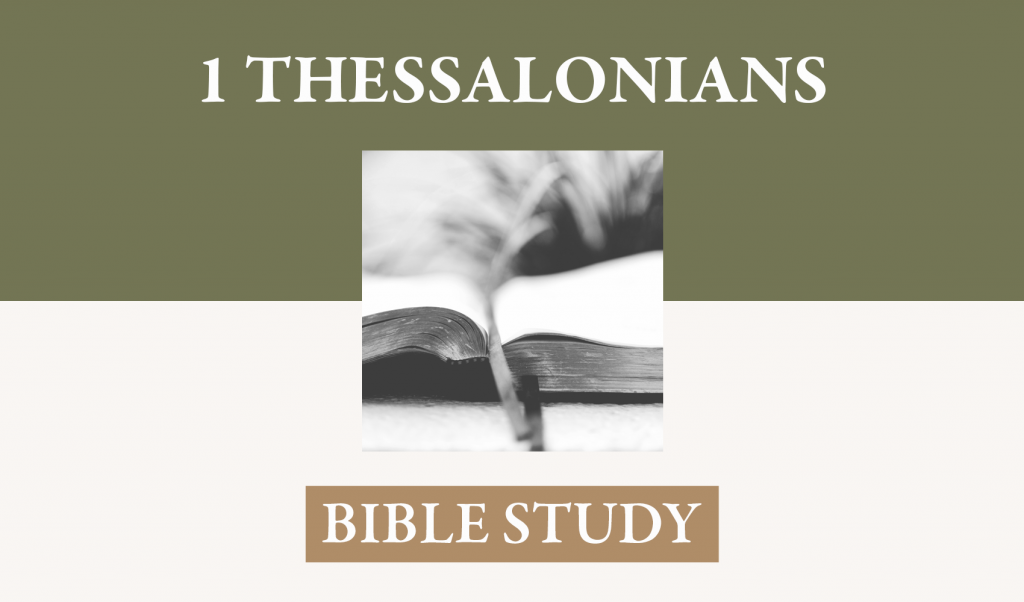I. The time of Christ’s return is not a necessary item of knowledge – verses 1, 2. Having told them something of the order of events at Christ’s coming to assure them of the well-being of departed loved ones who were believers, Paul now looks at the issue of when this will occur. That it will occur is certain and should be a motive for consistent heavenly living; when it will occur is not for us to know.
A. The two words that Paul uses concern chronology and critical moment.
-
- Is there a particular order of events in the world that will give certainty as to the time of Christ’s return? Will specific key events signal believers that the second and glorious appearing of Christ is at hand? He has told them that at the appearance of Christ, an archangel’s voice and a trumpet (4:16) will accompany his return. Are there key events that occur leading up to that time by which believers may anticipate with certainty that the Lord is about to make his triumphant entry to close this age?
- Also, is there a particularly critical event that gives the signal of his immediate appearance? Will something happen that makes us perk up our ears for the archangel’s shout and the trumpet’s sound? Jesus had given signs concerning his actions surrounding the coming destruction of Jerusalem (Matthew 24:3-28). Concerning his final appearance he said only, “Be ready.” Readiness for his return as well as readiness to suffer opposition is a trait of the entire age from Jesus’ ascension to his return in glory. When he appears the sons f light will rejoice but the “tribes of the earth will mourn, and they will see the Son of Man coming on the clouds of heaven with power and great glory” (Matthew 24:30).
B. They do not need any further instruction on this issue from Paul. He can give them no instructions on this, for it is hidden, as they should well know. These things already had been established in the common teachings in the Christian communities because of the words of Jesus himself.
-
- With the suddenness of the flood during the days of Noah, so quickly will the coming of the Son of Man be. “And they were unaware until the flood came and swept them all away, so will be the coming of the Son of Man” (Matthew 24:38, 39).
- In Matthew 24:43 (and Luke 12:39), Jesus anticipated Paul’s analogy of the unanticipated mischief of the thief’s coming: “But know this, that if the master of the house had known in what part of the night the thief was coming, he would have stayed awake and would not have let his house be broken into. Therefore, you must be ready, for the Son of Man is coming at an hour you do not expect” (Matthew 24:43, 44). Peter said it also, “The day of the Lord will come like a thief, and then the heavens will pass away with a roar” (2 Peter 3:10).
- At the close of the parable of the wise and foolish virgins, Jesus said, “Watch therefore, for you know neither the day nor the hour” (Matthew 25:13). In Mark 13:32, Jesus told his disciples, “But concerning that day or hour, no one knows, not even the angels in heaven, nor the Son, but only the Father” (See also Matthew 24:36). Even to Jesus in his humanity the knowledge of the time of his return was hidden. In his deity and as personal participant in the eternal covenant of redemption he knew with exhaustive detail all that would occur and when. That return had been set before the foundation of the world. As he submitted himself to the human condition throughout his life and walked, and ate, and rested, and slept, and hid himself and did not avail himself of the prerogatives of deity in many things, so, it seems, he reserved that knowledge for the Father, by whose authority it had been set. Even as he was ready to ascend, he told his disciples when they asked about the restoration of the kingdom, “It is not for you to know times or seasons that the Father has fixed by his own authority” Acts 1:7). It is a mystery.
II. The suddenness of Christ’s coming will be startling and deadly for the careless – Verse 3
A. False teachers seek to remove any aspect of judgment from the future. Jeremiah warned against those who say, “Peace, peace, when there is no peace” (Jeremiah 6:14). Ezekiel prophesied of coming judgment, but false prophets misled the people with words of “Peace when there is no peace.” But God had said, “I will make a stormy wind break out in my wrath, and there shall be a deluge of rain in my anger, and great hailstones in wrath to make a full end.” God was determined to destroy their false sense of security.
B. There are two ways is which the delusion of “peace and safety” can be assumed.
-
- One, some teachers reject the biblical certainty of final judgment that will result in eternal condemnation for some while others have eternal life. “These will go away into eternal punishment, but the righteous into eternal life” (Matthew 25:48). “And if anyone’s name was not found written in the book of life, he was thrown into the lake of fire” Revelation 20:15).
- Two, one may lose a sense of the certainty and quickness of Christ’s coming. He may believe that it will happen, and that judgment is real, but he never fosters any kind of urgency about readiness for judgment before the one whose “eyes were like a flame of fire” (Revelation 1:14). It is against this that the apostle warns his readers.
C. To those who do not expect it and who are unprepared, destruction will come suddenly. It can come by death and it certainly and finally will come by the Lord’s return. Jesus will sit in judgment over all and no final destination can be changed when he has come. It will come like labor pains on a woman. This image is used by Jesus in Mark 13:8 and Matthew 24:8.
D. Though they will look for a way to escape, none will find a way out: “and they will not escape.” A dramatic picture of the desire to escape the judgment of the coming Lord is found in Revelation 6:15-17: “Then the kings of the earth and the great ones and the generals and the rich and the powerful, and everyone, slave and free, hid themselves in the caves and among the rocks of the mountains, call to the mountains and rocks, ‘Fall on us and hide us for the face of him who is seated on the throne, and from the wrath of the Lamb, for the great day of their wrath has come, and who can stand?” Paul pictures the entire world standing before the perfect righteousness of the law of God, viewing its unwavering standard in comparison with the constant stream of transgression flowing for each human heart, mouth, and action. As they gaze they conclude that none can plead any excuse or extenuating circumstance—“every mouth may be stopped”—and all without exception will be accounted guilty—“the whole world may be held accountable to God” (Romans 3:19). “And they will not escape.”
III. Children of light need not know the time but bear the traits (Verses 4-8). The bags are always packed for those ready to complete the journey to heaven and live in God’s presence forever. They walk a heavenly path now and need not reverse course or find the proper gear and garb when the trumpet sounds and the voice of the archangel gives a shout.
A. “But you, brethren, are not in darkness” (4a). “We are not of night or of darkness” (5b).
-
- Darkness is a symbol of doing evil deeds. Paul recognized that they “actually do walk” even as he had instructed them “how you ought to walk.” He wanted them to do so “more and more” so that all that pertains to “sanctification and honor” would be progressively obvious in their conduct (4:1, 4). Darkness, the absence of light, supposedly provides a cover for the destructive and corrupt actions of those who seek the personal advantages of pleasure, possessions, and position. They forget that before the Lord in his knowledge, the darkness is light (Psalm 139:11, 12). John warned that “if we say that we have fellowship with him while we walk in darkness, we lie and do not practice the truth” (1 John 1:6).
- Darkness is a symbol of hiding from the knowledge of God. They had “turned to God from idols to serve a living and true God” (1:9). Formerly, like those in Ephesus, they were “darkened in their understanding, excluded from the life of God, because of the ignorance that is in them, because of the hardness of their hearts” (Ephesians 4:18). Jesus described the whole world, Jew and Gentile alike, in saying, “And this is the judgment; the light has come into the world, and people loved the darkness rather than the light because their deeds were evil” (John 3:19). Peter identifies the fulness of Scripture, the cumulative power of the words of the prophets with the more matured and brighter witness of the apostles as a “lamp that shines in a dark place.”
B. “You are all sons of light and sons of day” (5). The image of light runs throughout the New Testament writers as indicative of moral purity and a saving knowledge of Christ. The apostle John announced his message as this, “God is light, and in him is no darkness at all” (1 John 1:5). A literal translation could be, “In him darkness has no existence.”
-
- Light is the saving knowledge of Jesus Christ. “For God who said, ‘Let there be light” has shown in our hearts to give the light of the knowledge of the glory of God in the face of Jesus Christ” (2Corinthians 4:6). Peter described the scattered believers to whom he wrote as those who were “called out of darkness into his marvelous light” (1 Peter 2:9).
- Light, daytime, gives visibility to the path of righteousness. “He leads me in the paths of righteousness for his name’s sake” (Psalm 23:3). Paul used the images of day and night, darkness and light in his admonitions to the believers in Rome particularly in relation to their rejection of evil and pursuit of holiness: “The night is far gone; the day is at hand. So then let us cast off the works of darkness and put on the armor of light. Let us walk properly as in the daytime, not in orgies and drunkenness, not in sexual immorality and sensuality, not in quarreling and jealousy” (Romans 13:12, 13). We find these images used in direct correlation with the moral issues that they represent in 2 Corinthians 6:14b, 15a: “For what partnership has righteousness with lawlessness? Or what fellowship has light with darkness?”
- Those who live in the light will not find the day of Christ to be an invasion by a thief (4b). Their knowledge and expectation of his coming means that when he appears there will be no panic or confusion but only a loving marvel at the splendor of his coming. Instead of panic, worship and transformation will expand with Christ’s return—“to be marveled at among all who have believed” (2 Thessalonians 1:10); “We shall be like him for we shall him as he is. And everyone who thus hopes in him purifies himself as he is pure” (1 John 3:2, 3).
- The image of sleep is used for a state of unreadiness (6, 7) or worldly carelessness. “Stay awake, for you do not know on what day your Lord is coming” (Matthew 24:42). Sleeping is a symbol of the effects of darkness, for people sleep at night. Christians must cultivate a state of readiness and never slack in their expectation and desire for the coming of Christ. “Try to discern what is pleasing to the Lord. Take no part in the unfruitful works of darkness, but instead expose them. … When anything is exposed by light it becomes visible for anything that becomes visible is light. Therefore it says, ‘Awake, O Sleeper, and arise from the dead, and Christ will shine on you’” (Ephesians 5:10-14).
- Sobriety as opposed to drunkenness pictures a spirit of awareness and careful attention to responsibility. Again, night time is particularly the vulnerable time for drunkenness, so Christians are not people of the night, but of the day.
C. “The breastplate of faith and love” (8) as a mark of daytime sobriety shows that we know there is a constant need for protection from the assaults of wickedness and the enemies of God’s holy standards. Faith and love together constitute this protection of the vital organs of spiritual life. One would never place absolute trust in Christ unless he first loved him: “Though you have not seen him, you love him; though you do not now see him, you believe in him and rejoice with joy that is inexpressible and filled with glory, receiving the outcome of your faith, the salvation of your souls” (1 Peter 1:8, 9). The Holy Spirit in giving faith, first inspires love in the heart for the moral beauty and dying love of Christ, so that the natural reflex of the soul is to trust him and venture eternity upon his person and work.
D. Helmet, the hope of salvation (8). The hope of salvation means that freedom from the destitution of this fallen world and its godless affections is the chief objective for the future. He that has this hope in him purifies himself (1 John 3:3). The blessed hope to which we look forward and in light of which we are zealous for good works is the “glorious appearing of the great God and our savior, Jesus Christ” (Titus 2:13).
IV. God has made perfect provision for the suddenness, certainty, and severity of judgment – verses 9-11.
A. Though all persons in themselves are subject to the wrath of God, God has not destined believers for wrath (9). Many in the world will be objects of wrath on the great day of judgment and retribution (2 Thessalonians 1:8, 9; 2 Thessalonians 2:10-12).
B. Instead of wrath, God has elected from eternity past those who believe the gospel and called them by his truth and Spirit in time (1:4, 5). He has destined believers for obtaining salvation through our Lord Jesus Christ (9). Being saved from condemnation and wrath only comes through Jesus Christ. He alone embodies the righteousness that can match the law of God and he alone has paid the just price that satisfies the wrath of God.
C. In the only way that we could “obtain salvation,” Jesus died for us (10a), that is, took our place under the wrath that we deserve. The love given to believers before the foundation of the world included the necessity of Christ’s substitution for them under divine justice. Love and justice both were served and satisfied when “our Lord Jesus Christ … died for us.”
D. Union with Christ in his saving work can never be removed—“Whether we are awake or asleep, we will live together with him” (10b). Sleep here does not refer to a careless life, but to the reality of death—“We do not want you to be uninformed, brethren, about those who are asleep” (4:13). Death cannot separate us from the saving work of God that is found in union with the living Christ Jesus our Lord. This message means that neither the grave nor the subtle and restless intention of the evil one can separate believers from the love of God that is in Christ Jesus our Lord (Romans 8:38, 39).
E. This message of the suddenness of Christ’s coming and the dynamic of readiness and preparation on the part of believers is material for encouragement and edification. Paul looks at all doctrinal teaching as the source of encouragement, edification, rebuke, and exhortation.




















